Explore null | Canon Latin America

EOS C100
- EF-mount camera compatible with existing Canon EF and EF-S lenses
- Super 35mm Canon CMOS Sensor and DIGIC DV III Image Processor
- Amazing low-light performance
- Compact and ergonomic design meet a wide variety of application needs
- EOS C100 Body (with Grip/Camera cover R-F-3)
- Handle unit
- Battery Pack BP-955 (also available as optional accessory)
- Battery Charger CG-930
- Compact Power Adapter CA-930 (also available as optional accessory)
- Thumb rest
- Tripod base
- AC Cable x1
- DC Cable (for CA-930)
- Shoulder Strap SS-1200
- Data Import Utility Ver. 1.0
-
OVERVIEW
-
SPECIFICATIONS
-
ACCESSORIES
-
RESOURCES
-
SUPPORT
-
MISCELLANEOUS
Leave No Story Untold.
The EOS C100 is equipped with the advanced 16:9 Super 35mm Canon CMOS Image Sensor. The large sensor format allows for cinematic image capture by providing depth of field control and dynamic range characteristics reminiscent of film for truly arresting images. The 8.3 megapixel sensor maximizes pixel pitch to permit greater sensitivity in low light while minimizing noise. The unique sensor design allows the EOS C100 to captures independent Red, Green, and Blue channels for Full HD 1920x1080 video. The resulting picture features the color and image quality similar to that of a three-chip camera with a single sensor.

Designed and built by Canon for the highest quality HD RGB processing, the DIGIC DV III Image Processor uses proprietary circuits and architecture to deliver exceptional image quality at the highest speeds, with low power consumption and minimal heat output. It processes the RGB image data—originating from the single CMOS sensor of the camera—into three channels (Red, Blue and Green) to maintain the rich resolution and clean color fidelity formerly possible only in three-chip sensor designs.

Working together, Canon's Super 35mm sensor and DIGIC DV III Image Processor achieve a remarkably high signal-to-noise ratio that enables recordings with great detail and dynamic range even in minimal light. Users will appreciate the new camera's 12 stops of dynamic range at all ISO speed settings from 320 to 20,000.
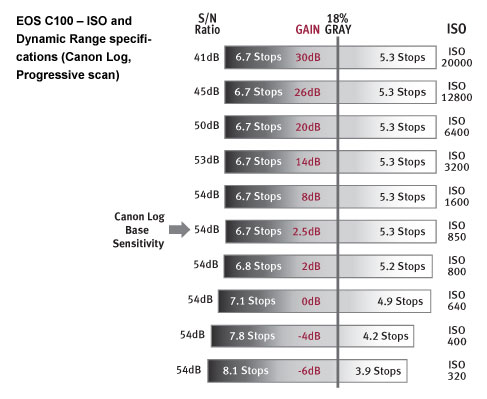
Canon Log Gamma preserves shadow and highlight detail for maximum editing and grading in post-production without degrading image quality; contrast and sharpness are subdued with characteristics similar to negative film. Canon Log Gamma emphasizes rich gradients from mid-range to highlights and realizes 12-stops of Dynamic Range (DR). At ISO 850 and above, Canon Log Gamma enables 5.3 stops of latitude above optimal exposure (and 6.7 stops below), broadening the available dynamic range in color grading.

Wide DR Gamma exhibits high dynamic range, suppressing brightness while maintaining seamless gradations. A wide dynamic range of 800% preserves latitude for post-production work, but Wide DR Gamma is designed for perfect color "out-of-the-box."
The EOS C100 supports shooting AVCHD bit rates up to 24Mbps (LPCM) at a maximum resolution of 1920x1080. Frame rates of 60i, PF30, PF24, 24p, 50i, and 25p are all available for any number of production workflows. In addition, the 60i frame rate offers reduced rolling shutter artifacts for cleaner, more realistic images. The EOS C100 supports relay recording of long takes between dual SD cards or can write video to both cards for redundancy in the event of SD card failure. Pre REC mode buffers approximately 3 seconds before the tally light activates, instilling confidence that you have captured your take as you planned it.
The EOS C100 offers complete manual control of each aspect of the recording process. Create and recall custom picture settings, camera functions, and display options. Built-in ND filters expand control over exposure and depth-of-field. Manual control of video and audio capture gives you the power to fully control what you capture.
The EOS C100 is equipped with several powerful and intuitive focusing aids in both the EVF and LCD monitor that make it easy to confirm critical focus distance; Peaking Modes and Magnify Focus Modes are available while in standby or while recording. The EOS C100 also features the Edge Monitor Display on the LCD Monitor; green waveforms display the overall focus of the scene and red waveforms provide focus feedback of the three focus check boxes visible on the LCD monitor.
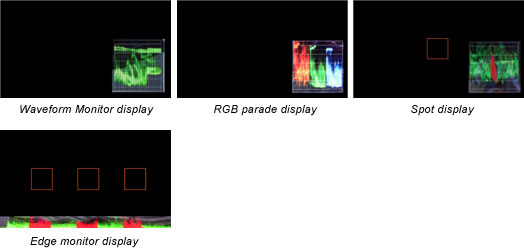
The EOS C100 is designed with the single user in mind. It is 85% smaller than the Canon C300, 410 grams lighter, and it is based on a mobile core design that allows additional accessories to be attached depending on the situation. Strip the EOS C100 down for a "run-and-gun" style, or complement the camera with the full range of camera-mounted accessories. With a compact body, you can shoot dual-camera 3D without an outsized and cumbersome rig. Its light weight reduces user fatigue and allows even elaborate rigging systems to be mobile enough for a "crew of one." The removable accessory hand grip rotates 360 degrees for comfortable shooting positions, while customizable hardware buttons allow the EOS C100 to fit your own personal shooting preferences.
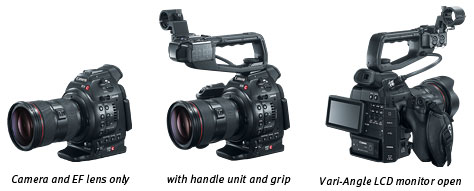
One-Shot AF assists in focusing adjustment with a dedicated button. Focus status is confirmed on the viewfinder and monitor.
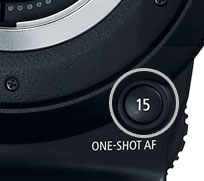
Push Auto Iris automatically adjusts the aperture of the lens to quickly and easily maintain proper exposure, even in situations where lighting changes frequently. Run-and-Gun videographers and documentary filmmakers will appreciate the ability to start rolling without a protracted routine to establish optimum exposure values.
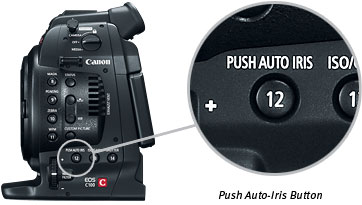
Accurately assess focus, composition, and exposure with the 1.56 million dot-equivalent .24" Electronic Viewfinder with 100% coverage. The built-in 3.5-inch 920k dot LCD tilts 100 degrees for flexibility when composing tough perspective shots and rotates 180 degrees to protect the screen when not in use. Use the LCD display to review footage or to view the EOS C100's waveform monitor.
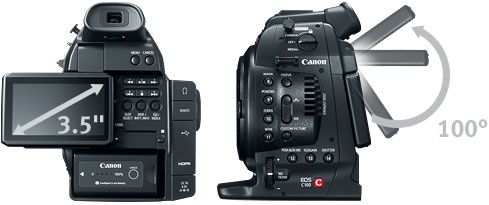
The EOS C100 accepts a removable hand grip unit with built-in tally lights, stereo microphone, and dual XLR audio inputs for stereo recording. Audio is captured in 16-bit 48 kHz linear PCM format and each channel allows for independent gain adjustment. Attach a second microphone in the integrated mount, or power a wide range of audio capture devices with the dual XLR inputs with phantom power supply.

EOS C100 records video to SD cards using AVCHD, a high-efficiency codec that has quickly become the standard in both the professional and consumer video markets. Maximum bit-rate is 24Mbps. Video files greater than 2GB are split into multiple files while recording, which are automatically joined together upon import using Canon Data Import. AVCHD video is widely supported across NLE systems and is the standard codec for Blu-Ray. The EOS C100 supports a variety of output media.
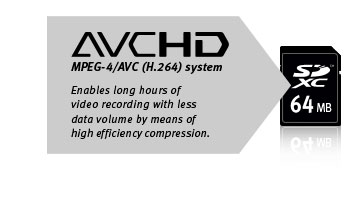
In addition to recording to SD cards, the EOS C100 can output video via HDMI to an external display for monitoring purposes or to a separate, dedicated recorder. Time Code is superimposed on data output via HDMI, making it easy to sync additional video or audio to your footage in post-production.
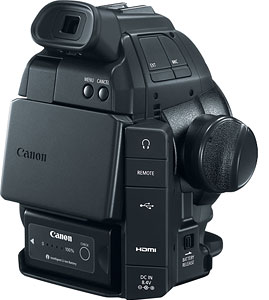
Remotely control the EOS C100 via its LANC-compatible remote terminal. Remote operation allows for single-person operation even in creative rigging situations.
| Standard Definition Or High Definition | High Definition | |||||||||||||||||||||||||||||||||||||||||||||||
| Power Supply Rated | 7.4 V DC (Battery Pack: BP-955), 8.4 V DC (DC IN) | |||||||||||||||||||||||||||||||||||||||||||||||
| Recording Codec | Signal System: NTSC And PAL Compression: MPEG-4 AVC/H.264 Color Space: 4:2:0 Maximum Bit Rate: 24Mbps Canon Log Gamma: Available File Format: AVCHD Recording Options:
|
|||||||||||||||||||||||||||||||||||||||||||||||
| Audio | 24 Mbps Mode: Linear PCM; 2-Channel; 16-Bit; 48 KHz All Other Modes: Dolby Digital AC3 Built-In Microphone: L/R External Audio Inputs: 2 - XLR Inputs (Auto And Manual Level Settings) External Microphone Terminal: (3.5 Mm Diameter) Recording Channel Selection: This Is Used To Set The Allocation Of The Audio Channels: CH1/CH2: The CH1 Signals Are Allocated To The L Output Channel, And The CH2 Signals Are Allocated To The R Output Channel. CH1/CH1: The CH1 Signals Are Allocated To The L Output Channel, And The CH1 Signals Are Allocated To The R Output Channel. CH2/CH2: The CH2 Signals Are Allocated To The L Output Channel, And The CH2 Signals Are Allocated To The R Output Channel. ALL CH/ALL CH: Signals Obtained By Mixing The CH1 And CH2 Signals Are Allocated To The L And R Output Channels. XLR Mic Trimming: Available; -12dB, -6 DB, 0dB, +6dB Or +12 DB Recording Level Adjustment Range: - Infinity To +18dB Phantom Power: Available; +48V Headphone Adjustment: 16 Settings; Volume Is Muted At Lowest Setting 1KHz Tone: Available: Available; -12, -18, Or -20 DB |
|||||||||||||||||||||||||||||||||||||||||||||||
| Image Sensor | Sensor Type: CMOS Sensor (Single-Panel) Equivalent To Super 35mm Sensor Size: 24.6 X 13.8 (28.2 Mm Diagonal); 6.4 Μm Cell Pitch Scanning System: Progressive Number Of Sensors: 1 Filter: RGB Primary Color Filter (Bayer Array) Imaging Processor: DIGIC DV III |
|||||||||||||||||||||||||||||||||||||||||||||||
| Effective Pixels | Approx. 8.29 Megapixels (3840 X 2160) | |||||||||||||||||||||||||||||||||||||||||||||||
| Total Pixels | Approx. 9.84 Megapixels (4206 X 2340) | |||||||||||||||||||||||||||||||||||||||||||||||
| Max Movie Recording Time | (1) Recording Media: SD/SDHC/SDXC Card (2) Number Of Slots: 2 Note: Movie And Photo Recording Is Enabled. Also, Custom Pictures (20 Files) And Settings Of Data Such As Menus Can Be Recorded. Recording Media Operation Results: A List Of Cards That Can Be Used For Recording Will Be Provided Separately. Clips Of 59.94 Hz And 50.00 Hz Modes Cannot Be Stored Together On A Single Media Device. The Maximum Continuous Recording Time Is 12 Hours. When This Time Has Elapsed, Recording Will Stop Automatically. When Continuous Recording Is Performed, Data Is Divided Up In 2 GB Files. When 50 Files Are Recorded For 1 Clip, Recording Will Stop Automatically.
|
|||||||||||||||||||||||||||||||||||||||||||||||
| Lens | Interchangeable: EF Mount For Compatibility EF, EF-S And EOS Cinema Lens Systems (Non-PL). | |||||||||||||||||||||||||||||||||||||||||||||||
| Focusing System | Manual; One-Shot AF Autofocus System Is Available; AF Is Dependent On Interchangeable Lenses |
|||||||||||||||||||||||||||||||||||||||||||||||
| Max Shutter Speed | 1/2000 Sec. | |||||||||||||||||||||||||||||||||||||||||||||||
| Iso Range | 320 To 20,000 In 1-Step And 1/3-Step Increments | |||||||||||||||||||||||||||||||||||||||||||||||
| Nd Filter Settings | Mechanical ND Filter System With Option Of Clear, 2, 4, And 6 Stops | |||||||||||||||||||||||||||||||||||||||||||||||
| White Balance | AWB, Kelvin Setting (Setting Range: 2000K To 15000K), Daylight, Tungsten, Set A, Set B | |||||||||||||||||||||||||||||||||||||||||||||||
| Frame Rate | NTSC: 60i, 30p, 24p PAL: 50i, 25p |
|||||||||||||||||||||||||||||||||||||||||||||||
| Minimum Illumination | 59.94 Hz: 0.3 Lux 50 Hz: 0.25 Lux |
|||||||||||||||||||||||||||||||||||||||||||||||
| Illumination Correction | Available | |||||||||||||||||||||||||||||||||||||||||||||||
| Genlock Terminal | N/A | |||||||||||||||||||||||||||||||||||||||||||||||
| Hd Sd Sdi Terminal | N/A | |||||||||||||||||||||||||||||||||||||||||||||||
| Timecode Terminals | N/A | |||||||||||||||||||||||||||||||||||||||||||||||
| Viewfinder | 0.24-Inch (0.61 Cm Diagonal) Color Wide-Screen LCD With 16:9 Aspect Ratio Equivalent To Approx. 1.555 Million Dots (960 X RGB X 540), 100% Field Of View Ratio |
|||||||||||||||||||||||||||||||||||||||||||||||
| Lcd Screen Monitor Unit | 3.5-Inch (8.8 Cm Diagonal) Color Wide-Screen LCD With 16:9 Aspect Ratio Equivalent To Approx. 922,000 Dots (640 X RGB X 480), 100% Field Of View Ratio |
|||||||||||||||||||||||||||||||||||||||||||||||
| Microphone | Stereo (Electret Condenser Microphone) | |||||||||||||||||||||||||||||||||||||||||||||||
| Recording Media | SD Card X2 (Video, Still Images (JPEG), Custom Picture Data*, Clip Metadata, And Menu Settings); SD/SDHC/SDXC Supported; MMC Cards Are Not Supported *Custom Picture Data And Settings Is Not Compatible With Data From Others Canon Models |
|||||||||||||||||||||||||||||||||||||||||||||||
| Usb Terminal | Mini-B, Hi-Speed USB | |||||||||||||||||||||||||||||||||||||||||||||||
| Video Terminal | 3.5 Mm 4-Pole Mini Jack Out Only | |||||||||||||||||||||||||||||||||||||||||||||||
| Audio Terminal | 2 - Balanced 3-Pin XLR (Mic Level, Mic Level With Phantom Power And Line Level) In Handle Unit | |||||||||||||||||||||||||||||||||||||||||||||||
| Hdmi Terminal | Yes (Type A) Time Code Can Be Superimposed | |||||||||||||||||||||||||||||||||||||||||||||||
| Av Mini Terminal Headphone Terminal | 3.5mm Stereo Mini-Jack | |||||||||||||||||||||||||||||||||||||||||||||||
| Wft Terminal | N/A | |||||||||||||||||||||||||||||||||||||||||||||||
| Operating Temperature Range | Performance Requirements: 0°C To 40°C, 85% (Relative Humidity) Operating Requirements: 0°C To 45°C, 60% (Relative Humidity) |
|||||||||||||||||||||||||||||||||||||||||||||||
| Dimensions W X H X D | C100 (Body Plus Thumb Rest): Approx. 5.3 X 6.7 X 5.1 In (135 X 170 X 129 Mm) C100 (Body Plus Grip): C100 (Body Plus Thumb Rest Plus Handle): C100 (Body Plus Grip Plus Handle): |
|||||||||||||||||||||||||||||||||||||||||||||||
| Weight Not Including Lens | Main Unit: C100 Body: Approx. TBA Lb. / TBA G Grip: Approx. 8.1 Oz. / 230 G |
|||||||||||||||||||||||||||||||||||||||||||||||
- Windows Server 2025
- macOS 14
- macOS 13
- Windows 11
- macOS 12
- Windows Server 2022
- macOS 11
- Linux MIPS
- Linux ARM
- macOS 10.15
- macOS v10.13
- macOS v10.14
- Windows Server 2019 (x64)
- macOS v10.14
- macOS v10.13
- Windows Server 2016 (x64)
- macOS Sierra v10.12
- Linux 64bit
- Linux 32bit
- OS X v10.11
- Windows 10
- Windows 10 (x64)
- OS X v10.10
- OS X v10.9
- Windows Server 2012 R2 (x64)
- Windows 8.1 (x64)
- Windows 8.1
- Windows Server 2012 (x64)
- Windows 8
- Windows 8 (x64)
- Windows 7
- Windows 7 (x64)
- Windows Vista
- Windows Vista (x64)
- Windows XP
- Windows XP (x64)
- Windows Server 2008
- Windows Server 2008 (x64)
- Windows Server 2008 R2 (x64)
- Windows Server 2003
- Windows Server 2003 (x64)
- Windows Server 2003 R2
- Windows Server 2003 R2 (x64)
- Windows 2000
- Windows NT
- Windows 3.1
- Windows Me
- Windows 98
- Windows 95
- Mac OS X v10.8
- Mac OS X v10.7
- Mac OS X v10.6
- Mac OS X v10.5
- Mac OS X v10.4
- Mac OS X v10.3
- Mac OS X v10.2
- Mac OS X v10.1
- Mac OS X
- Mac OS 9
- Mac OS 8
- Linux (x64)
- Linux (x32)
- Linux
Locating and Installing Your Download Cómo Localizar e Instalar su Descarga Localizando e Instalando seu Download
How to identify your OS version
To help determine which Windows operating system is running on your computer, please view the below steps:
Windows 11
Click on the Windows button (located left to the Search at the bottom).
Click on the Settings button to navigate to the system settings.
Scroll to the bottom of the page and click on the About button.
You will be able to find your Windows operating system under the Windows Specifications section.
Windows® 10
Click Start or click the Windows button (usually found in the lower-left corner of your screen).
Click Settings.
Click About (which is usually located within the lower left of the screen). The next screen should display the Windows version.
Windows 8 or Windows 8.1
Option1: Swipe in from the upper-right corner of the screen while viewing the desktop in order to open the menu, then select Settings.
Select PC Info. Under Windows edition, the Windows version is shown.
Option 2: From the Start Screen
While on the Start screen, type computer.
Right-click on the computer icon. If using touch, press and hold on the computer icon.
Click or tap Properties. Under Windows edition, the Windows version is shown.
Windows 7
Click Start or click the Windows button (usually found in the lower-left corner of your screen).
Right-click Computer and select Properties from the menu. The resulting screen should now display the Windows version.
Linux
To check the version of your Linux operating system (OS), you can use the following commands in your terminal:
1. uname -r: Displays your Linux kernel version.
2. cat /etc/os-release: Displays your distribution name and version.
3. lsb_release -a: Displays specific details about your Linux distribution and version.
4. You can also use the hostnamectl command to display the Linux kernel version. However, this command is only available on Linux distributions that use systemd by default.
To help determine which Mac operating system is running on your computer, select the Apple menu in the upper-left corner of your screen and choose About This Mac.
Upon selecting, you should see the macOS name followed by the version number.
Canon U.S.A Inc. All Rights Reserved. Reproduction in whole or part without permission is prohibited.